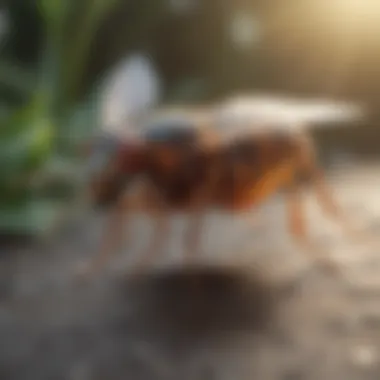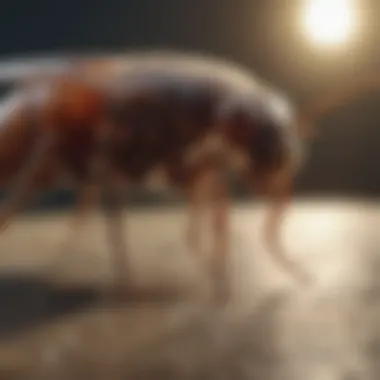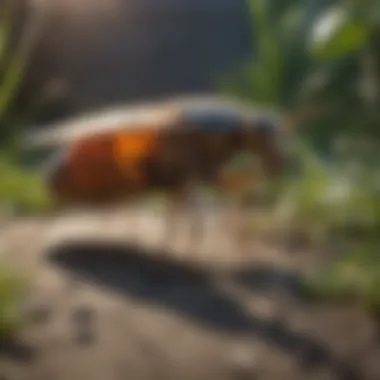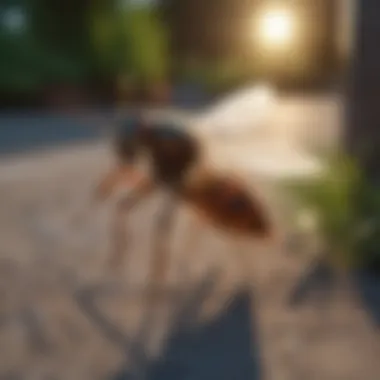Natural Flea Control: Eco-Friendly Outdoor Solutions


Intro
Outdoor spaces invite a variety of life, including pests such as fleas. These small insects thrive in gardens and yards, posing challenges for homeowners. They are not just a nuisance. Their bites can cause discomfort to pets and humans alike. Understanding fleas is crucial in tackling their presence effectively. This article will dive into the lifecycle of fleas, their environmental impact, and provide practical solutions rooted in natural methods for control.
Identification of Common Pests
Fleas are among the most common pests that infest outdoor areas. Primarily, the cat flea, Ctenocephalides felis, and the dog flea, Ctenocephalides canis, are often found. You may also encounter other species in certain regions.
Description of Common Pests
Fleas are tiny, wingless insects that jump. Their bodies are flattened laterally, which aids in moving through fur and feathers. An adult flea can range from 1 to 3 mm in size. They have a brownish color, making them difficult to spot when they are on grass or soil.
Signs of Infestation
Identifying a flea infestation quickly is crucial to management efforts. Here are some signs to look for:
- Flea droppings: These look like tiny black specks on pet beds or in areas where pets frequent.
- Pet itching: If your pet is suddenly scratching more than usual, fleas may be the cause.
- Visible fleas: You may actually see fleas on your pets or in the yard, especially during hot, humid weather.
- Bites on humans: Flea bites often appear as small red dots, typically around the ankles and legs.
Prevention Techniques
Preventing fleas from taking residence in your yard is more effective than dealing with an infestation afterward. Here are essential strategies.
Home Maintenance Tips
- Regular cleaning: Vacuum your home often, especially areas where pets roam. Be sure to dispose of vacuum bags or empty canisters outside to prevent fleas from re-entering.
- Yard maintenance: Keep grass trimmed and debris clear to reduce flea habitats. Fleas prefer shadey, moist areas.
- Wash bedding: Ensure pet bedding is laundered regularly in hot water to eliminate any potential eggs or larvae.
Environmental Modifications
- Create a sunny environment: Fleas thrive in damp, shady areas. Trim bushes and remove foliage to allow sun-light in, which deters these pests.
- Promote dry conditions: Fleas need moisture to survive. Avoid over-watering your lawn and garden.
Eco-Friendly Pest Control Options
There are several natural ways to manage fleas. These options focus on sustainable practices, ensuring safety for both humans and pets.
Natural Pesticides
- Diatomaceous earth: This powdery substance harms fleas as they come into contact with it, leading to dehydration. Spread it in affected areas, being careful around pets.
- Neem oil: Derived from the seeds of the neem tree, this oil has insecticidal properties. Dilute it with water and spray it in your yard to deter fleas.
Organic Pest Control Techniques
- Essential oils: Oils like lavender, peppermint, and eucalyptus can repel fleas. Mix a few drops with water and spray around your outdoor area.
- Beneficial nematodes: These microscopic worms can be introduced to your garden. They prey on flea larvae and help reduce the population naturally.
Question your assumptions about pest management. Natural solutions can be just as effective as traditional pesticides, often with fewer risks.
Implementing these strategies can foster a flea-free outdoor space, allowing you and your family to enjoy the beauty of your environment. Stay tuned as we delve deeper into other aspects of natural flea management.
Understanding Fleas
Understanding fleas is crucial for managing their presence in outdoor spaces. Fleas are more than just a nuisance; they can cause distress to pets and damage to lawns and gardens. By comprehending their biology and behavior, homeowners can better implement natural solutions to keep their surroundings flea-free.
Overview of Fleas
Fleas are small, wingless insects that feed on the blood of mammals and birds. Their bodies are flattened, which allows them to navigate through fur or feathers easily. Fleas can jump several inches, making them adept at moving between hosts. They play a significant role in the ecosystem, but their ability to reproduce quickly often leads to infestations.
Lifecycle of Fleas


The flea lifecycle consists of four distinct stages: egg, larva, pupa, and adult. Understanding this lifecycle is essential for effective flea control. Each stage presents a unique opportunity for intervention.
Egg Stage
The egg stage is the first phase of a flea's life. Flea eggs are tiny and often laid in clumps, making them difficult to notice. A single female flea can lay dozens of eggs daily, and these eggs can fall off hosts into various environments. The rapid reproduction rate highlights the need for proactive measures in outdoor flea management since a small number of fleas can lead to a significant population increase.
Lava Stage
After a few days, flea eggs hatch into larvae. This stage is critical for control efforts. Larvae avoid light and inhabit dark places like under foliage or in soil. During this stage, larvae feast on organic debris, including flea feces, which contain digested blood. The presence of larvae indicates ongoing infestations, so addressing them is vital to diminish flea populations.
Pupal Stage
The pupal stage follows the larval stage and is a crucial transitional phase for fleas. Fleas can remain in this stage for extended periods, sometimes months, especially if environmental conditions are not favorable. They can sense vibrations and carbon dioxide, which help them emerge when a host is near. Understanding this stage allows homeowners to recognize why persistent flea issues may linger even after treatments.
Adult Phase
The adult phase is when fleas become visible and begin their lifecycle anew. Adult fleas are adept at finding hosts and can consume several times their body weight in blood. This stage poses the most immediate threat to pets and humans as the adults are responsible for bites and irritation. Thus, controlling the adult population is crucial for effective flea management.
Common Types of Fleas
Several species of fleas can infest homes and gardens, but the most common types include the cat flea, dog flea, and human flea. Each type has specific habits and preferred hosts, but all can lead to infestations when not managed properly.
In summary, understanding fleas allows homeowners to identify and mitigate infestations proactively. Knowing their lifecycle stages ensures the implementation of effective natural control measures tailored to each stage.
Identifying Flea Infestations
Identifying flea infestations is crucial for effective control and management. Fleas can easily invade your outdoor spaces, leading to discomfort for both pets and humans. Recognizing the signs of an infestation allows homeowners to take prompt action, minimizing the negative impacts these pests can have. Moreover, understanding where fleas are likely to thrive can enhance prevention strategies. Without early detection, flea populations can grow rapidly, resulting in larger infestations which are more challenging to eliminate.
Signs of Infestation
To determine if fleas are present in your outdoor environment, look for several key indicators. Common signs of infestation include:
- Flea Bites: If you or your pets experience itchy, red bumps, this can signal the presence of fleas.
- Flea Dirt: Flea feces, often described as black specks in your pet's fur or around sleeping areas, is a clear sign of an infestation. It looks like small grains of pepper and is composed of digested blood.
- Pet Behavior Changes: Observe your pets. If they are frequently scratching, biting at their skin, or showing signs of discomfort, this may indicate fleas.
- Visible Fleas: Spotting adult fleas jumping on surfaces or animals is a definite confirmation.
Regular checks in suspected areas, especially after outdoor activities, can help catch infestations early.
Common Areas for Fleas Outdoors
Fleas can be found in various locations outdoors. Here are the most common areas to check:
Yards and Gardens
Yards and gardens are often prime locations for flea infestations. These areas provide an ideal environment for fleas to thrive, with ample cover from grass and foliage. Fleas can easily latch onto pets that roam these spaces, then enter the home. Regular maintenance is essential to manage the flea population effectively.
- Key Characteristic: The presence of shade and foliage offers protection for fleas and their potential hosts.
- Unique Feature: The combination of vegetation, moisture, and warmth creates an inviting habitat for fleas.
- Advantages: By maintaining a well-groomed yard, homeowners can reduce potential flea habitats.
Pets' Sleeping Areas
Pets' sleeping areas are another common hotspot for flea activity. Areas where pets rest are more likely to harbor fleas, given their close proximity to the animals. It’s critical to keep these spots clean and check for flea presence regularly.
- Key Characteristic: Pets tend to leave behind fur and skin flakes, which can attract fleas.
- Unique Feature: These areas are typically warmer, providing a conducive environment for fleas.
- Advantages: Frequent washing and vacuuming can significantly reduce flea populations around pets.
Wooded Areas
Wooded areas can also be a significant source of fleas. These locations provide natural habitats not only for fleas but also for their animal hosts. Wildlife such as raccoons or deer can carry fleas into nearby residential areas.
- Key Characteristic: Wooded areas offer dense vegetation and moisture, making them attractive to fleas.
- Unique Feature: The diversity of wildlife creates an ongoing risk of flea introduction into nearby lawns and gardens.
- Advantages: While it's hard to control fleas in wooded areas, being aware of potential infestations can promote early detection and action.


Natural Flea Control Methods
Natural flea control methods are crucial for managing outdoor environments. By utilizing eco-friendly solutions, homeowners can effectively reduce flea populations without relying on chemical pesticides. These methods promote a healthier living space for both humans and pets. Understanding the various options available can empower homeowners to choose the right methods that align with their values and needs.
Diatomaceous Earth
Diatomaceous earth is a naturally occurring substance made from the fossilized remains of tiny aquatic organisms called diatoms. This powdery material is effective in controlling fleas in various outdoor areas. When fleas come into contact with diatomaceous earth, it disrupts their exoskeleton and leads to dehydration, ultimately killing them. It is safe for humans and pets, making it a popular choice among environmentally conscious homeowners.
When applying diatomaceous earth, it is important to ensure even coverage in areas where fleas are likely to inhabit. This includes yards, garden beds, and spots frequented by pets. Regular reapplication may be necessary, especially after rain or watering.
Essential Oils
Essential oils provide a natural alternative for repelling fleas. Their aromatic properties can deter these pests while offering a pleasant scent to outdoor spaces. However, safe application and proper knowledge about recommended oils are essential for their effectiveness.
Application Techniques
Applying essential oils effectively is key to maximizing their deterrent properties. Using a diffuser outdoors can spread the scent effectively, while mixed oils can be sprayed on pet bedding and favorite outdoor spots. It's crucial to ensure that the oils don’t come into direct contact with skin, especially for pets.
Dilution is necessary. Good practice is to mix a few drops of essential oil with a carrier oil or water before application. This approach not only helps to prevent irritation but also extends the life of the scent in outdoor settings.
Recommended Oils
Some essential oils are particularly noted for their effectiveness against fleas. Oils such as lavender, peppermint, and eucalyptus are well-regarded. Each oil has unique properties that make them useful in flea management.
Lavender is calming for pets and humans alike while also repelling fleas. Peppermint offers a sharp aroma that fleas typically avoid. Eucalyptus is known to have natural insect-repelling qualities.
It is worth noting that while essential oils are generally safe, some pets may have sensitivities. Therefore, always monitor pets for adverse reactions after application.
Salt Treatment
Salt acts as a dehydrating material. By spreading salt in areas with flea activity, homeowners can create an environment where fleas struggle to survive. Salt works by drawing moisture out of the flea, effectively killing them in the process.
However, it is important to use salt carefully as it can affect soil health and nearby plants. Thorough application followed by controlled watering may help to minimize potential damage.
Vinegar Solutions
Vinegar is valued for its versatility in household cleaning and pest control. A mixture of vinegar and water can be sprayed in areas prone to fleas. The strong scent of vinegar can also deter fleas from breeding.
This solution is typically safe around pets and gardens, making it an excellent option for flea management. Little reapplication may be needed, especially in damp areas that can wash away the solution.
Boric Acid
Boric acid works as an effective solution for controlling flea populations. When applied properly, it can target fleas in all lifecycle stages. It is a common ingredient in many pest control products, yet it remains safe when used in moderation.
Generally, boric acid can be sprinkled in areas where fleas are frequent. Vacuuming may be required to encourage further effectiveness, as it will help to circulate the solution. Homeowners should apply caution to avoid harming pets or children when using this treatment.
Preventative Measures
Preventative measures are critical for effective flea management. They not only reduce the risk of infestations but also ensure that outdoor spaces remain comfortable and safe for both pets and humans. Taking a proactive approach is essential, as it can minimize the reliance on more invasive treatments later on. A combination of regular maintenance, pet care, and environmental adjustments can lead to sustainable flea control.
Being diligent about these measures can significantly decrease the likelihood of encountering flea problems. It is much easier to prevent an infestation than to eradicate one. Careful attention to specific practices can create conditions that are less inviting for fleas.
Regular Lawn Maintenance
Mowing


Mowing is a straightforward yet impactful action. By keeping grass short, it becomes less favorable for fleas to thrive. Fleas prefer longer grass as it provides shade and moisture. Regular mowing exposes their habitat to light and airflow, helping keep flea populations at bay.
Moreover, well-maintained lawns are generally healthier. A healthy lawn often discourages flea activity. It's important to mow regularly during the growing season to maintain this beneficial effect. One downside might be that over-mowing can stress the grass, but the advantages of reducing flea habitats far outweigh this risk.
Mulching
Mulching presents another effective strategy. Applying a layer of mulch in garden beds can suppress flea activity by creating unfavorable conditions for their lifecycle. Wood chips, straw, or shredded leaves act as natural barriers. They help regulate moisture and temperature in the soil, preventing fleas from flourishing.
Besides that, mulching can enhance the overall landscape by adding visual appeal and additional nutrients as it breaks down. However, choosing the right type of mulch is key, as some materials may attract other pests. Overall, the advantages of mulching for flea control and garden health make it a reliable choice.
Keeping Pets Flea-Free
Maintaining pets’ flea control is vital. Regularly grooming pets and using natural flea prevention products can significantly lower the chance of fleas spreading into outdoor spaces. Daily brushing can help remove any fleas or eggs present. Additionally, using natural repellents can provide extra protection without harmful chemicals. This practice keeps pets healthy and creates an overall barrier against fleas.
Owners should also ensure that pets are treated regularly, especially during flea season. These efforts can dramatically reduce flea populations both on animals and around the home.
Creating a Non-Flea Habitat
Choosing Plants Wisely
Selecting the right plants is integral to managing fleas effectively. Certain plants have natural flea-repellent properties. For instance, rosemary, lavender, and marigolds can deter fleas while enhancing your garden's aesthetic. These plants not only repel fleas but also attract beneficial insects that help control other pest populations.
Opting for native plants can also contribute to a balanced ecosystem. They are typically better adapted to local conditions and need less care, making them less likely to attract pests. The challenge here is ensuring proper placement of these plants to maximize their effect. However, the reward is a healthier and more vibrant outdoor space.
Managing Damp Areas
Addressing damp areas in the yard is crucial. Fleas thrive in moisture-rich environments, which can be a breeding ground for them. Ensuring good drainage and reducing standing water are effective strategies. Regularly check for damp spots, especially after rain, and consider adding gravel or dry mulch to improve drainage.
Managing dampness not only diminishes flea populations but also promotes a healthier lawn overall. An indirect benefit is that reducing moisture can also help prevent the growth of mold and mildew, contributing to better air quality. The effort invested in monitoring and adjusting these areas pays off in the long run.
Evaluating Effectiveness of Treatments
Evaluating the effectiveness of flea treatments is essential for any homeowner dealing with infestations. In this section, we delve into practical methods to gauge how well treatments perform, the significance of this evaluation, and how to adapt strategies to achieve the best results.
Monitoring the impact of implemented flea control measures helps in understanding what works and what doesn't. By keeping a close eye on the results, you can avoid wasting resources on ineffective treatments, thus saving both time and money. Additionally, knowing how effective a treatment has been can inform future decisions, ensuring you always use the best methods available.
Monitoring Flea Activity
Monitoring flea activity involves observing the presence of fleas in your outdoor environment. To get started, it is helpful to routinely inspect areas where pets frequently roam or where family members often gather. Look for signs such as flea droppings, bites on pets or humans, and an increase in scratching behaviors. You can also employ simple traps made from soapy water and light to attract and capture fleas, allowing you to physically account for their numbers.
Consistency is key when monitoring flea activity. Regular checks will help you notice trends, such as increases correlating with certain treatments. Recordkeeping can prove beneficial; consider noting down the date of observations and the severity of flea presence in a journal. This will create a clearer picture of changes over time and help in evaluating treatment outcomes effectively.
Adjusting Treatment Strategies
Once you have monitored flea activity and assessed the effectiveness of treatments, it is important to be flexible with your approach. If certain methods appear less effective, consider adjusting your strategy accordingly. For example, if diatomaceous earth is not yielding results, assess the application method or perhaps switch to using essential oils or boric acid instead.
Another aspect of adjusting treatment strategies involves seasonal changes. Fleas thrive in warm, humid conditions, so it can be useful to change tactics based on the time of year. During drought conditions, fleas might be less prevalent, whereas a wet rainy season may enhance their population. Stay informed about flea lifecycles and adjust your tactics accordingly, ensuring that your treatments are relevant to current conditions.
In summary, evaluating the effectiveness of treatments requires a systematic approach to monitoring flea activity and adjusting strategies accordingly. By paying careful attention to results, you can achieve a more effective flea management plan in your outdoor spaces.
"Successful flea management is not a one-time effort; it requires evaluation and adaptability to remain effective over time."
Summary and Culmination
The topic of outdoor flea management holds significant importance in maintaining a healthy and enjoyable living environment. Fleas can be more than just an annoyance; they affect both pets and humans. Understanding effective natural solutions provides homeowners with practical methods to manage and eliminate flea infestations sustainably.
This article has highlighted various natural treatments, including diatomaceous earth, essential oils, salt treatment, vinegar solutions, and boric acid. Each method has its specific applications and advantages. For instance, diatomaceous earth acts as a desiccant that disrupts flea lifecycle, while essential oils provide a more aromatic deterrent. Such variety allows for flexibility in approach, catering to different preferences and situations.
Additionally, preventative measures are equally crucial. Regular lawn maintenance, keeping pets flea-free, and creating a non-flea habitat further reduce the risk of infestations. Homeowners can significantly lower flea populations by making these simple changes in their care routine. This proactive approach is beneficial not only in preventing existing problems but also in minimizing future re-infestations.
Ultimately, the significance of understanding and utilizing natural solutions for flea management cannot be overstated. By choosing eco-friendly methods, homeowners contribute to a healthier environment while effectively managing pests. The integration of household items and sustainable practices ensures that flea control is accessible and practical for everyone.
In summary, tackling outdoor flea infestations with eco-friendly solutions enriches the conventional pest management approach. Homeowners can confidently address flea issues while ensuring the safety of their families and pets. Utilizing the insights shared throughout this article empowers readers with the necessary knowledge to create a flea-free outdoor space.







